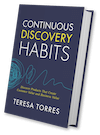 Have you heard? My new book Continuous Discovery Habits is now available. Get the product trio's guide to a structured and sustainable approach to continuous discovery.
Have you heard? My new book Continuous Discovery Habits is now available. Get the product trio's guide to a structured and sustainable approach to continuous discovery. Does this sound familiar? You spend weeks researching a problem. Your team whiteboards multiple solutions. You user test each one. You build the best one. And despite great feedback from your users along the way, when you finally release, all you get are complaints.
Change Is Hard
The reality is, change is hard. Even if your new version is better than your old version, even if you built exactly what they asked for, your users are still going to have to adjust to the change. It will still be disruptive.
Knowing this, how can we manage the distruption? How can we make the change as easy as possible?
And If we know our users are going to complain about any change, even the good ones, how do we know what feedback to listen to and what feedback is a symptom of adjusting to change?
We Can Learn From Facebook
Fortunately, Facebook excels at this. And we can learn a lot from what they have done over the years.
If you used Facebook when they first rolled out the newsfeed, you might remember the uproar it caused. It was disruptive. Overnight a million people threatened to quit. And this was back when Facebook wasn’t very big.
It’s hard to imagine Facebook today without the newsfeed. This was clearly a good change. Arguably, it’s what made Facebook the success it is today. So why the uproar?
The newsfeed fundamentally changed the way we use Facebook. Rather than interacting with people on their profiles, we now interacted with them in our newsfeed. This was jarring. And Facebook did little to prepare us for it.
And then they did it again with Beacon.
Remember that fiasco?
But fortunately, Facebook learned. And we can learn vicariously through them.
Facebook Got It Right With Timeline
Whether you love it or hate it, Facebook’s roll out of Timeline did a tremendous job of managing the change process. Let’s look at a few things they did well.
The announced the change well in advance.
Unlike newsfeed, Facebook didn’t just roll out Timeline. They announced to the world that it was coming. This allowed then to socialize the concept.
We got to come to terms with the idea of Timeline before it impacted our experience on the site. This allowed each of us to start the transition and undergo many of the emotional aspects of the change process. It minimized the disruption.
They allowed users to opt-in to the change.
Second, they allowed early adopters to opt-in. This does two things. It allows people to feel like they have some control over their own experience. There is a very big difference between “I choose this” and “this was forced on me.”
It also allowed Facebook to test the change on a set of users that were most receptive to the change. This likely minimized the “change is hard” feedback, allowing the team to focus on. the actual product feedback.
They listened and learned.
With a group of self-selected early adopters, Facebook was able to listen and learn about what was actually working and not working with Timeline. They were able to improve the product before imposing it on everybody.
They set a hard deadline for when everyone would get the change.
Just as important as the earlier steps, Facebook didn’t stay in limbo forever. They gave themselves enough time to work out the product kinks, but eventually they rolled Timeline out to everyone.
They undoubtably heard a lot of “change is hard” feedback. This process doesn’t eliminate that. But because the product was already vetted by the self-selected early adopters, Facebook could safely ignore the “change is hard” feedback, knowing the change was a good one.
What are you doing to minimize the impact of your product changes? How do you know what feedback to ignore and what you need to respond to?
This is brilliant, Teresa. In my opinion, the hardest part of change is the adoption period. As you stated, people object ( often loudly) to “newness.” We often confuse objections to “newness” as objections to “betterness” ( don’t think that’s a word, but hope you get the point.) Your advice is very helpful in helping change leaders smooth the adoption process as much as possible.
I like “betterness.” 🙂
So simple and yet so hard to do! Great advice Teresa.
Great post! In some ways this reminds me of the French parenting term, “cadre” (Which I learned from Bringing up Bebe). Cadre is the French word for frame, and the idea is that you give kids a firm frame – boundaries – of acceptable behavior, but within that frame you try to give kids as much freedom as possible. The analogy here being, Facebook did provide a hard deadline: this was a change that was happening, no matter what. But, users had options for when they transitioned and the advance notice gave users power and discretion up until the deadline.
Good tips on managing change Teresa! The listening and learning one is the most important one in my mind.
I’m glad you liked it.